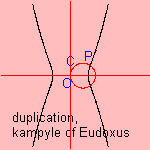
|
 |
 |
 |
 |
 |
 |
kampyle of Eudoxus |
quartic |

 This quartic curve has been studied by Eudoxus of Cnide (406-355 BC), an
astronomer, philosopher and mathematician who was a pupil of Plato.
This quartic curve has been studied by Eudoxus of Cnide (406-355 BC), an
astronomer, philosopher and mathematician who was a pupil of Plato.
Eudoxus
worked on the curve in relation to the classical problem of the duplication of the cube.
Let there be a circle C through O with radius √1/2, which cuts the kampyle in P.
Then OP has as length 3√2
 In polar coordinates the curve can be written as r = cos -2 φ.
In polar coordinates the curve can be written as r = cos -2 φ.
The kampyle 1) is also named Clairaut's curve.
And the kampyle is:
- the radial of the catenary
- the inverse of the double
egg
Its Cartesian equation resembles the equation of the lemniscate of Gerono.
1) Kampyle (Gr.) = curved